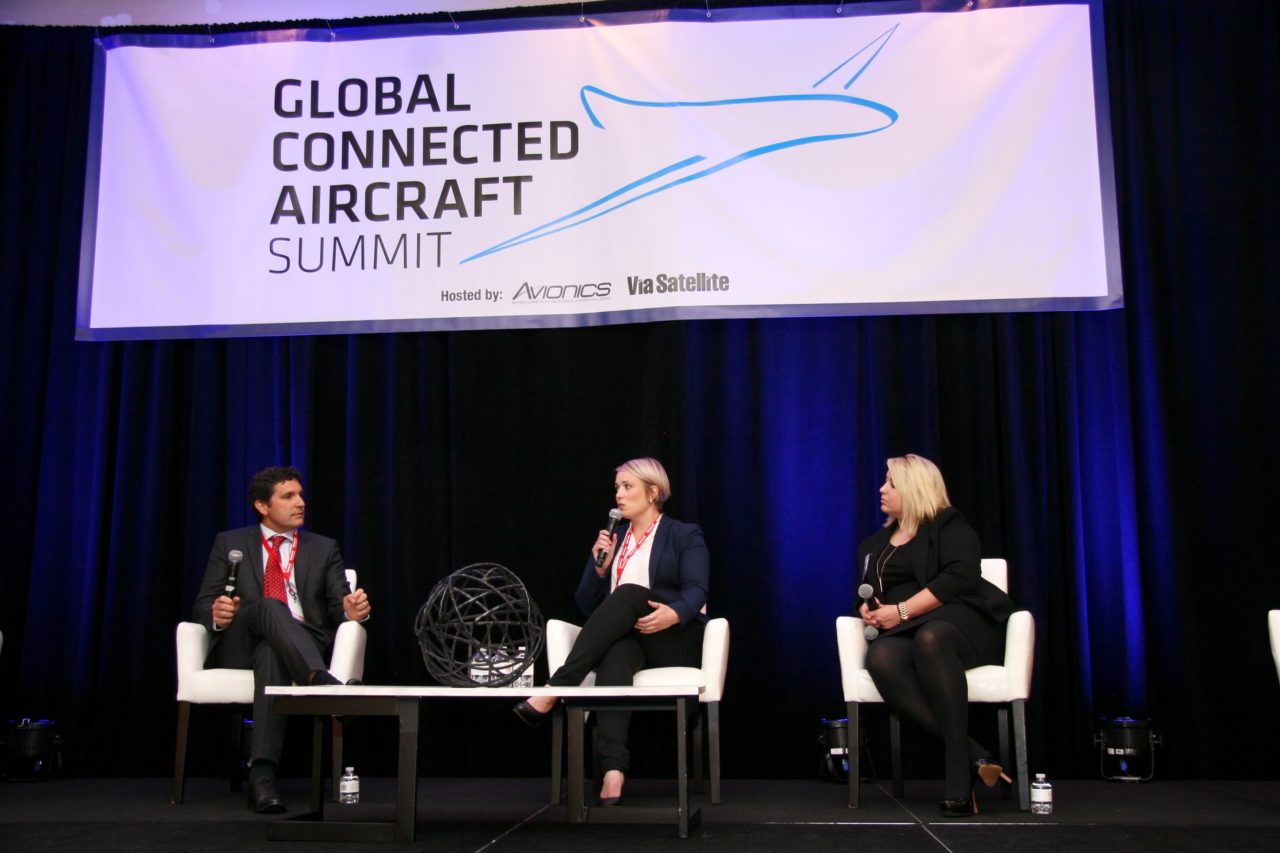Free In-Flight Connectivity Remains a Long-Term Goal for Airlines

L-R: Matthieu Dolle, Air France In-Flight Connectivity (IFC) product manager; Ingigerdur Erlingsdottir, Icelandair project manager for marketing and business development; Tara Bamburg, Southwest Airlines associate manager of product development. Photo: Vince Lim.
According to panelists at the Global Connected Aircraft Summit, the technology that powers connectivity must still make some strides before most airlines can afford to offer free Wi-Fi services. As guest speakers shared their thoughts on passenger experience on Thursday, they concluded that a business model where customers pay for connectivity will continue to be the norm for the foreseeable future.
Icelandair, for example, already has its entire fleet connected and is working on simplifying the experience for its customers, said Ingigerdur Erlingsdottir, project manager for marketing and business development. But although the company is able to provide a range of services for its passengers, the cost of bandwidth is still too high for the airline to offer those services for free. “As soon as it is less costly for us it’s more likely to become free,” Erlingsdottir said. Unfortunately, she added, some customers already expect to be connected for no cost.
Interestingly, Erlingsdottir highlighted a difference in culture between American and European passengers. “We have two different pricings from routes to Europe and North America, and we’re seeing quite a difference in the usage between those routes. It seems that North America is more prepared to pay for connectivity than Europe has been,” she said. “We’re seeing twice as much takeup in routes to America.”
Erlingsdottir suggested a few likely explanations for the difference, the first being that North American frequent flyers have grown accustomed to connectivity on their domestic flights. Also, because flights through Europe are generally shorter, customers are less willing to pay to stay connected — and if they do, it’s because they have to for business purposes rather than for entertainment.
Currently, Icelandair offers free connectivity to just a small subset of its customers — “Gold members” — which is a business model that many other airlines have adopted as well.
Southwest Airlines also has a split model, with only its “A-list preferred” customers receiving the service for free, said Tara Bamburg, Southwest’s associate manager of product development. For its other customers, the airline charges $8 for all-day use on a device. “We feel that $8 is reasonable for the service we offer currently,” she said. “I think as more airlines enter into the space and start setting their own pricing models, we’re going to see a shifting in that.”
In particular, Bamburg said she expects to see more tiered business models emerge based on the differing connectivity speeds airlines can offer. “You’ll start to see really similar pricing across the entire industry,” she said.
Bamburg noted too that she believes Southwest customers understand the technical limitations of offering ubiquitous free Wi-Fi. “I’ve sat in a crowded coffee shop,” she explained. When there are dozens, if not hundreds, of devices all competing for the same bandwidth, it “degrades the overall experience,” she said, which is why many Southwest customers don’t see $8 as a unfair financial investment for a full day of use.
Meeting customers’ expectations for high-speed connectivity continues to be a major challenge for airline operators. “We’re always going to lag behind what’s going on on the ground, but customers’ expectations don’t lag behind that,” Bamburg said. For that reason, she said, Southwest Airlines is now focusing maximizing speed for its customers to encourage higher take-up rates.
“We are struggling to keep up with the demands from the customers. People want to have reliable services and connect at the same speeds at home. This is not currently applicable, at least not to our fleet,” Erlingsdottir added. “Keeping up with the high-speed demands… [is] going to be the most challenging thing for us.”
Air France expects to run into the same issue as it begins the process of connecting its fleet, said Matthieu Dolle, the company’s In-Flight Connectivity (IFC) product manager. By the end of the year, Air France will have just five aircraft connected. And while Dolle said he personally believes in the free business model, the technology currently available simply “cannot offer a good experience” to all customers on all flights at all times. “We need an improvement of the technology first,” he said.
But even as new, more powerful assets such as Flat Panel Antennas (FPAs) emerge, it will take time for airlines to integrate the hardware into their fleets. “When you take an airplane out of service, every day it’s sitting on the ground is a day it’s not making money,” said Bamburg. “If we know that those planes are going to be retiring, it doesn’t make sense to ground them and not receive the revenues associated with them. Connectivity is an added value and an expectation for our customers, but it’s not worth grounding a plane for multiple days.”
Ultimately, the panelists agreed that while offering adequate connectivity services is important, it is just one of a number of factors that influence how an airline runs its business cost-effectively.
“Connectivity is just piece of the many ancillary products airlines make available,” Bamburg said.
“The cost of the ticket will ultimately decide who you are flying with,” Erlingsdottir added.